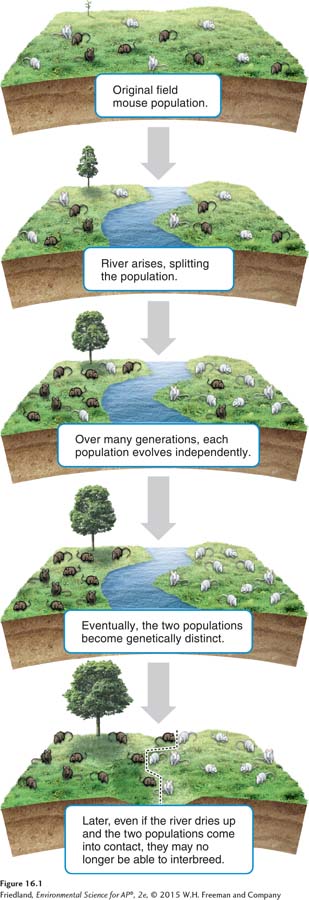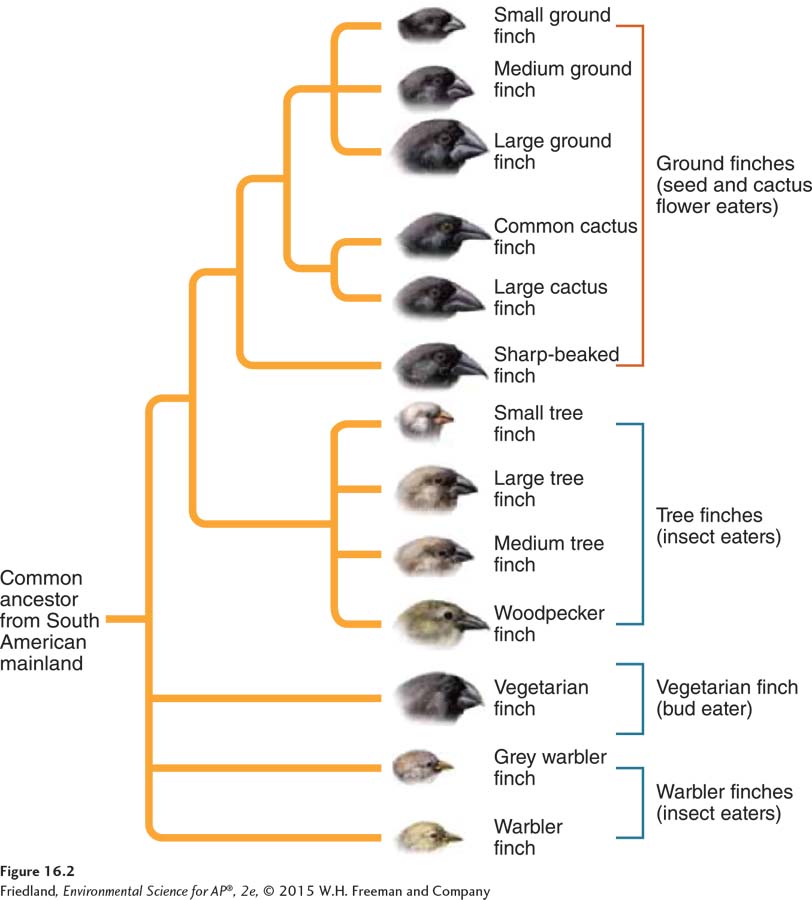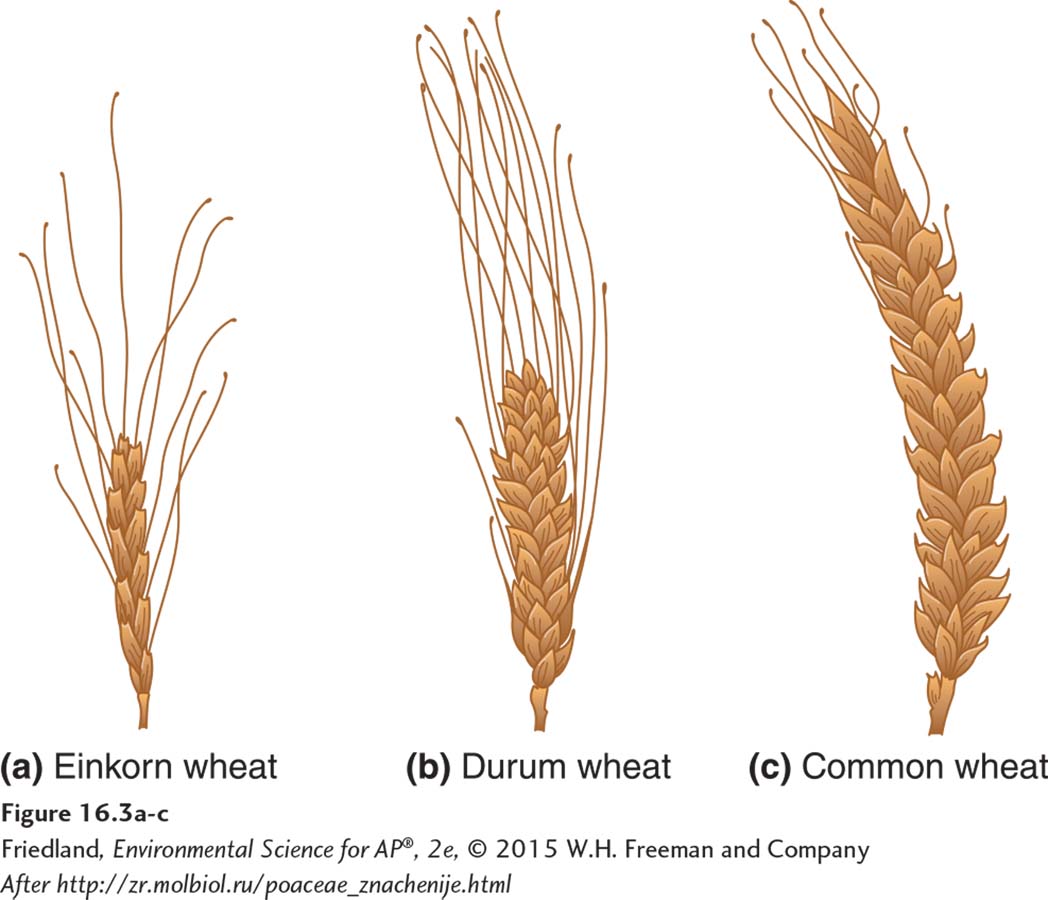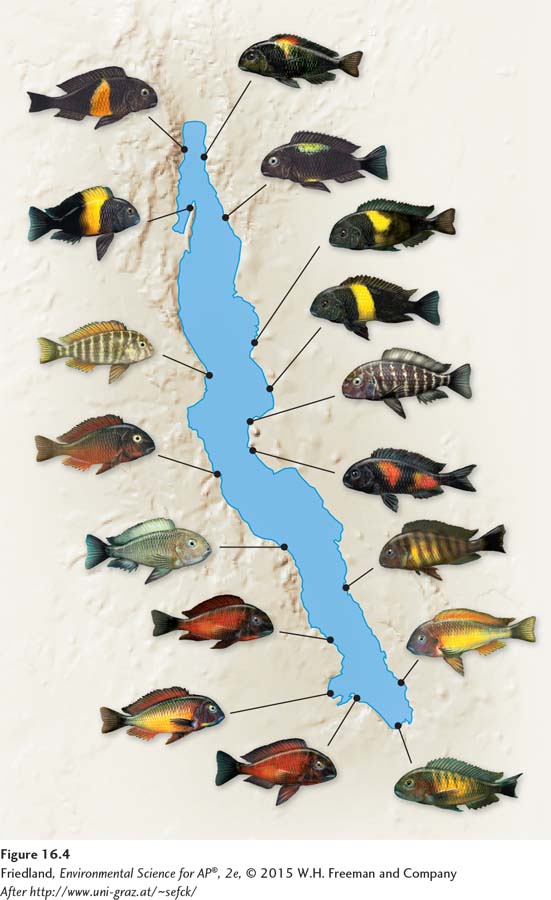module 16 Speciation and the Pace of Evolution
Over time, speciation has given rise to the millions of species present on Earth today. Beyond determining how many species exist, environmental scientists are also interested in understanding how quickly existing species can change, how quickly new species can evolve, and how quickly species can go extinct. In this section we will examine the processes that produce new species and the factors that determine how rapidly species can evolve in response to changes in the environment.
Learning Objectives
After reading this module you should be able to
explain the processes of allopatric and sympatric speciation.
understand the factors that affect the pace of evolution.
Speciation can be allopatric or sympatric
Microevolution is happening all around us, from the breeding of agricultural crops, to the unintentional evolution of drug-
Allopatric speciation
Geographic isolation Physical separation of a group of individuals from others of the same species.
Allopatric speciation The process of speciation that occurs with geographic isolation.
One common way in which evolution creates new species is through geographic isolation, which means the physical separation of a group of individuals from others of the same species. The process of speciation that occurs with geographic isolation is known as allopatric speciation (from the Greek allos, meaning “other,” and patris, meaning “fatherland”). As shown in FIGURE 16.1, geographic isolation can occur when a subset of individuals from a larger population colonizes a new area of habitat that is physically separated from that larger population. For example, a single large population of field mice might be split into two smaller populations as geographic barriers change over time. For example, a river might change course and divide a large prairie into two halves, a large lake might split into two smaller lakes, or a new mountain range could rise. In such cases, the genetic composition of the isolated populations might diverge over time, either because of random processes or because natural selection favors different adaptations on each side of the barrier.

Reproductive isolation The result of two populations within a species evolving separately to the point that they can no longer interbreed and produce viable offspring.
If the two separated habitats differ in environmental conditions, such as temperature, precipitation, or the occurrence of predators, natural selection will favor different phenotypes in each of the habitats. If individuals cannot move between the populations, then over time the two geographically isolated populations will continue to become more and more genetically distinct. Eventually, the two populations will be separated not only by geographic isolation but also by reproductive isolation, which means the two populations of a species have evolved separately to the point that they can no longer interbreed and produce viable offspring. At this point, the two populations will have become distinct species.
Allopatric speciation is thought to be responsible for the diversity of the group of birds known as Darwin’s finches. When Charles Darwin visited the Galápagos Islands, located just west of Ecuador, he noted a large variety of finch species, each of which seemed to live in different habitats or to eat different foods. Research on these birds has demonstrated that they all share a common ancestor that colonized the islands from the mainland long ago. FIGURE 16.2 is a phylogenetic tree for these finches. Over a few million years, as Darwin discovered, the finches that were geographically isolated on different islands became genetically distinct and eventually became reproductively isolated.

Sympatric Speciation
Sympatric speciation The evolution of one species into two, without geographic isolation.
Allopatric speciation is thought to be the most common way in which evolution generates new species. However, it is not the only way. Sympatric speciation is the evolution of one species into two species without geographic isolation. It usually happens through a process known as polyploidy. Most organisms are diploid: They have two sets of chromosomes. In polyploidy, the number of chromosomes increases to three, four, or even six sets. Such increases can occur during the division of reproductive cells, either accidentally in nature or as a result of deliberate human actions. Plant breeders, for example, have found several ways to interrupt the normal cell division process. Polyploid organisms include some species of snails and salamanders, 15 percent of all flowering plant species, and a wide variety of agricultural crops such as bananas, strawberries, and wheat. As FIGURE 16.3 shows for wheat, polyploidy often results in larger plants and larger fruits.

The key feature of polyploid organisms is that once they become polyploid, they generally cannot interbreed with their diploid ancestors. At the instant polyploidy occurs, the polyploid and diploid organisms are reproductively isolated from each other and are therefore distinct species, even though they may continue to live in the same place.
The pace of evolution depends on several factors
How long does evolution take? A significant change in a species’ genotype and phenotype, such as an adaptation to a completely different food source, can take anywhere from hundreds to millions of years. In this section, we will consider examples of rapid evolution by natural selection and very rapid evolution by artificial selection.

Rapid Evolution by Natural Selection
Sometimes evolution can occur rapidly, as in the case of the cichlid fishes of Lake Tanganyika, one of the African Great Lakes. You can see a variety of these species in FIGURE 16.4. Evidence indicates that the roughly 200 different species of cichlids in the lake evolved from a single ancestral species over a period of several million years. During this period, some cichlid species specialized to become insect eaters and others to become fish eaters, while still others evolved to eat invertebrates such as snails and clams.
Although the cichlids of Lake Tanganyika evolved quickly in evolutionary terms, the pupfishes of the Death Valley region of California and Nevada evolved even more rapidly. In the 20,000 to 30,000 years since the large lakes of the region were reduced to isolated springs, several species of pupfish have evolved.
The ability of a species to survive an environmental change depends greatly on how quickly it evolves the adaptations needed to thrive and reproduce under the new conditions. If a species cannot adapt quickly enough, it will go extinct. This can happen when the rate of environmental change is faster than the rate at which evolution can respond. Slow rates of evolution can occur when a population has long generation times or when a population contains low genetic variation on which natural selection can act.
Very Rapid Evolution by Artificial Selection
The pace of evolution by artificial selection can be incredibly fast. Such rapid evolution is occurring in many species of commercially harvested fish, including the Atlantic cod (Gadus morhua). Intensive fishing over several decades has targeted the largest adults, selectively removing most of those individuals from the population and, therefore, also removing the genes that produce large adults. Because larger fish tend to reach sexual maturity later, the genes that code for a later onset of sexual maturity have also been removed. As a result, after just a few decades of intensive fishing, the Atlantic cod population has evolved to reach reproductive maturity at a smaller size and a younger age. This evolution of shorter generation times also means that the cod may be able to evolve even faster in the future.
Genetically modified organism (GMO) An organism produced by copying genes from a species with a desirable trait and inserting them into another species.
Evolution occurs even more rapidly in populations of genetically modified organisms. Using genetic engineering techniques, scientists can now copy genes from a species with some desirable trait, such as rapid growth or disease resistance. Scientists can insert these genes into other species of plants, animals, or microbes to produce genetically modified organisms (GMO). When those organisms reproduce, they pass on the inserted genes to their offspring. For example, scientists have found that a soil bacterium (Bacillus thuringiensis) naturally produces an insecticide as a defense against being consumed by insects in the soil. Plant breeders have identified the bacterial genes that are responsible for making the insecticide, copied those genes, and inserted them into the genomes of crop plants. Such crops can now naturally produce their own insecticide, which makes them less attractive to insect herbivores. Common examples include Bt-